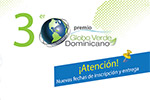Otter 501
Friday, September 6th at 10:00 AM Santo Domingo, FUNGLODE
Topic of panel:
Why Save Endangered Species?
Say “cheese” mother earth! - Nature Photography
Friday, September 6th at 4:00 pm Santo Domingo, FUNGLODE
Go Wild with GoPro!
Saturday, September 7th at 4:00 pm Santo Domingo, FUNGLODE
Globo Verde Dominicano Award
Saturday, September 7 at 8 PM Santo Domingo, FUNGLODE
Topic of panel:
Environmental film: An Effective Tool for Eco Education
Places
Santo Domingo
Santo Domingo, the capital and largest city of the Dominican Republic, covers an area of approximately 1,401 square kilometers and currently has a population of 2,193,046. Santo Domingo was the first settlement established in the New World and is considered the cradle of evangelization in the Americas. Having served as the set for internationally renowned, big budget films such as The Godfather II, Havana and LaFiesta del Chivo (The Feast of the Goat), among others, consolidated Santo Domingo’s relationship with the Seventh Art.
- Biblioteca Infantil y Juvenil
República Dominicana - Centro Cultural Narciso González
- FUNGLODE
- Palacio del Cine-Agora Mall
- The American School of Santo Domingo
- Universidad Nacional Pedro Henríquez Ureña
Santiago de los Caballeros
In addition to being the country’s second largest city, Santiago is the most important city in the province of the same name. Its rum and liquor have acquired international fame, contributing to the economic development of the city while its land is mainly used for crops and agriculture. Santiago, an area of 2,389 kilometers, is well-known for its industrial free zones and deeply rooted cultural traditions, which are expressed in the province’s rich and diverse folklore and art. Santiago is also known for being home to one of the country’s most popular baseball teams – the Las Aguilas Cibaeñas.
- Centro Cultural Eduardo León Jimenes
Puerto Plata
Puerto Plata, the largest city on the northern seaboard, covers an area of 509 square kilometers and has a population of 286,558. Playa Dorada and Costa Dorada beaches make tourism one of the staples of its economy, but agribusiness is also important to the city. The port around which Puerto Plata was built is one of the most active in the Caribbean and has a major impact on both the provincial and national economy. Another distinguishing feature of the city is an aerial tramway that takes visitors up the 793-meter Isabel de Torres Mountain, which borders the city. At the top of the mountain is a botanical garden and a replica of the famous Christ the Redeemer statue seen in Rio de Janeiro, Brazil.
- Escuela Plan Reforma
- Colegio Santa Rosa de Lima
- Universidad Dominicana O&M
- Universidad UTESA
- Comunidad de los Domínguez
Punta Cana
Punta Cana, the country’s most popular tourist destination, is in the easternmost province of the Dominican Republic, about an hour from the province’s capital city, Higüey and 3 hours from Santo Domingo. The area is best known for its sandy beaches that spread across nearly 100 kilometers of coastline. Punta Cana has an estimated population of about 100,000 people. PUNTACANA Resort and Club, founded by Grupo PUNTACANA in the 1970s, is one of the oldest resorts in the area. Recognized as a leader in sustainable tourism, the resort encompasses over 15,000 acres and includes a spa, two championship golf courses, an Ecological Reserve with 15 natural springs, a full service marina, several restaurants and a shopping village. In addition to the PUNTACANA Hotel, Dominican fashion icon Oscar de la Renta designed the luxurious Tortuga Bay Villas, the only Five Star hotel, according to the AAA, in the Dominican Republic. In honor of its responsible luxury practices, its ecological establishment, and golf course water-preservation system, among other efforts, the resort received the 2011 Travel + Leisure Global Vision Award and the 2009 Condé Nast World Savers Award.
- Galerías PUNTACANA Village
San Francisco de Macorís
Situated in the heart of the Dominican Republic, San Francisco de Macorís is the fourth-largest city in the country with a population of 245,397 and an area of 727 square kilometers. It is the capital of Duarte province, located in the northern region of Cibao, which is known for its rich, black soil and fertile farmlands. San Francisco de Macorís represents the agroindustry in the Dominican Republic, as it is one of the largest producers of various products from cacao and coffee to fruit and rice. The city is also home to one of the largest universities in the DR, the Nordestana Catholic University (UCNE).
- Universidad Católica Nordestana - UCNE
- Centro de Educación Continua
Baní
Baní, the capital of Peravia province, is one of the new additions to the roster of venues for the DR Environmental Film Festival. The city, with nearly 62,000 residents who live on its 743.79 square kilometers, is only about an hour’s drive west of Santo Domingo along the Southern coast of the Dominican Republic. Baní is a tightly-knit agricultural community known for its production of bananas, coffee and mangoes, which are celebrated every June at Baní’s annual mango festival, attracting visitors from all over the country. Located in the nearby Peravia province is Salinas, a town near Salinas Bay, which is famous for its huge sand dunes, the largest dunes in the Caribbean. Many famous baseball players hail from Baní, including José Bautista of the Toronto Blue Jays. It is also said that the world-famous Bachata group, Aventura, got its start playing in Baní’s clubs and bars.
- Centro Cultural Perelló
Sosúa
Located just a 10-minute drive from Puerto Plata, Sosúa is another north-coast Dominican town nourished by the tourism industry. With a population of about 70,000 people on 276 square kilometers, Sosúa’s beautiful beaches attract many water sports enthusiasts because of their sheltered calm waters, diverse fish species and intricate reef structures. In the winter, whale watching is also a popular tourist activity, with excursions leaving frequently from Sosúa Bay, especially in February. A popular destination for Europeans, there is a large expatriate community in Sosúa, which consists mostly of German, British, American and Canadian expats. Sosúa also has the largest Jewish community in the Dominican Republic. This is the result of Dominican dictator Rafael Trujillo having given asylum to around 100,000 Jews in 1938, the majority of whom settled in Sosúa and continue to operate the dairy and cheese factory, Productos Sosúa, which they built on land and with resources provided by the Trujillo government at that time.
- Sosúa Bay Grand Casino
San Juan de la Maguana
San Juan de la Maguana, is the main municipality of San Juan province, on the western side of the country. With a population of 241,100 on 876.21 square kilometers of land, San Juan is renowned for its fertile soil and moderate climate, suitable for cultivation of cereals and legumes such as beans and rice which are the main ingredients in the Dominican diet. In the DREFF’s three year history, this is the first time the Festival will take place in San Juan, a city distinguished by its colonial history. The city’s indigenous leader, Caonabo, whose name means “Great Lord of the Earth,” became the most important and powerful ruler in Hispaniola by leading the Taíno revolt against the Spanish.
- Centro Cultural Monina Cámpora








